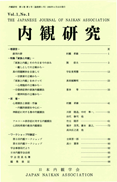Volume 21, Issue 1
Displaying 1-10 of 10 articles from this issue
- |<
- <
- 1
- >
- >|
OPENING REMARKS
-
2015Volume 21Issue 1 Pages 1
Published: September 10, 2015
Released on J-STAGE: December 26, 2020
Download PDF (862K)
SPECIAL ARTICLES
-
2015Volume 21Issue 1 Pages 3-17
Published: September 10, 2015
Released on J-STAGE: December 26, 2020
Download PDF (1199K)
SYMPOSIUM
-
2015Volume 21Issue 1 Pages 19-22
Published: September 10, 2015
Released on J-STAGE: December 26, 2020
Download PDF (902K)
POINT OF CONTENTION
-
2015Volume 21Issue 1 Pages 23-28
Published: September 10, 2015
Released on J-STAGE: December 26, 2020
Download PDF (901K)
ORIGINAL ARTICLES
-
2015Volume 21Issue 1 Pages 29-41
Published: September 10, 2015
Released on J-STAGE: December 26, 2020
Download PDF (3308K) -
2015Volume 21Issue 1 Pages 43-57
Published: September 10, 2015
Released on J-STAGE: December 26, 2020
Download PDF (2695K)
SHORT REPORT
-
2015Volume 21Issue 1 Pages 59-63
Published: September 10, 2015
Released on J-STAGE: December 26, 2020
Download PDF (1392K) -
2015Volume 21Issue 1 Pages 65-71
Published: September 10, 2015
Released on J-STAGE: December 26, 2020
Download PDF (1321K) -
2015Volume 21Issue 1 Pages 73-81
Published: September 10, 2015
Released on J-STAGE: December 26, 2020
Download PDF (1634K) -
2015Volume 21Issue 1 Pages 83-91
Published: September 10, 2015
Released on J-STAGE: December 26, 2020
Download PDF (3200K)
- |<
- <
- 1
- >
- >|
